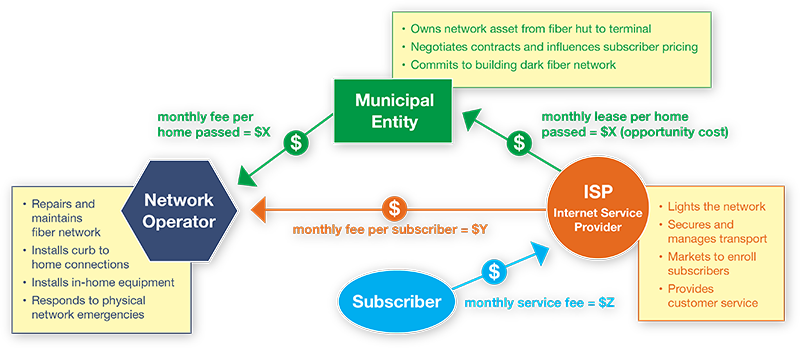
Dark Fiber: Lighting the Way for Municipal Broadband Networks
A Public Ownership Model for Municipal Broadband Networks creates pathways to universal connectivity
Broadband has quickly become a priority for local governments as leaders increasingly recognize high-speed internet as an essential utility like electricity and water. Without it, communities are held back from connecting with opportunities to thrive.
Currently, there are three primary broadband options for communities to consider:
- Private telecom expansion. Incumbent providers pay to upgrade and/or expand existing cable networks to improve service in underserved areas and/or connect unserved areas. The network is privately controlled, and the infrastructure technology may or not be fiber optic.
- Private 3rd party overbuilds. New fiber optic networks independently built by private broadband providers in select areas based on market profitability. The network is privately controlled, and there is no promise or guarantee of universal service.
- Municipal fiber-to-the-home (FTTH). New public fiber networks built by municipal entities through public-private partnerships (P3) to provide universal connectivity to every home and business. Municipal entities retain network ownership and control over operations, pricing, and access.
Municipal FTTH is the only option that guarantees universal connectivity and gives network control to local broadband entities.
Consider P3 Dark Fiber
Sertex offers a financial model that makes municipal FTTH more affordable and reduces the degree of financial risk assumed by local entities. Shared at the Connecticut Conference of Municipalities 2022 Annual Convention, the Sertex P3 Dark Fiber model is a true partnership where all entities assume shared risk.
Here is how it works…
- The public entity (a town or regional authority) commits to financing the infrastructure costs for a core fiber optic network and contracts with a construction partner to execute the build.
- The public entity maintains ownership of all network assets from the fiber hut to the terminal.
- Once the core network is built, the public entity contracts with an Internet Service Provider (ISP) and a Network Operator to install FTTH connections to homes and businesses, activate broadband service for all subscribers, and operate the network.
- Each home the dark fiber passes represents an opportunity for the ISP to provide service, for which the ISP pays a monthly lease to the public entity.
- The public entity then pays the Network Operator a monthly fee based on the number of homes passed for ongoing maintenance and emergency services.
- As new subscribers sign on, the ISP engages the network operator to install curb-to-home connections and in-home equipment for each subscriber.
- Over time, successful networks can invite competition by leasing excess fiber access to other ISPs willing to provide service.

Lighting the Last Mile
Every community must determine the path it wants to take to achieve broadband connectivity. Considering the options, the easy choice may be to give control to private entities. However, this decision comes with significant risks – squandering resources in old technology, deepening the digital divide, and giving away local control.
Sertex’s P3 Dark Fiber model can bring lightspeed internet with future-proof technology, universal connectivity, and ownership control for municipalities willing to invest in their community.

